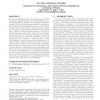Free Online Productivity Tools
i2Speak
i2Symbol
i2OCR
iTex2Img
iWeb2Print
iWeb2Shot
i2Type
iPdf2Split
iPdf2Merge
i2Bopomofo
i2Arabic
i2Style
i2Image
i2PDF
iLatex2Rtf
Sci2ools
GIS
2009
ACM
2009
ACM
Data structures and intersection algorithms for 3D spatial data types
Apart from visualization tasks, three-dimensional (3D) data management features are not or only hardly available in current spatial database systems and Geographic Information Systems (GIS). But the increasing demands from application domains like urban planning, geoscience, and soil engineering call for systems that are capable of storing, retrieving, querying, and manipulating the underlying 3D spatial data. Current 3D data models are tailored to specific applications and simple 3D spatial objects only, and available 3D data structures are restricted to main memory representations; thus they lack the ability of handling general and complex 3D spatial objects in a database context. Available algorithms, especially intersection algorithms for 3D objects, usually require special properties like convexity or monotonicity. Therefore, universal intersection algorithms that are capable of handling general 3D spatial objects are currently unknown. This paper proposes a paradigm called slic...
| Added | 25 Jul 2010 |
| Updated | 25 Jul 2010 |
| Type | Conference |
| Year | 2009 |
| Where | GIS |
| Authors | Tao Chen, Markus Schneider |
Comments (0)

